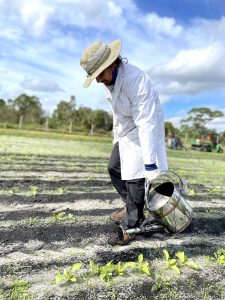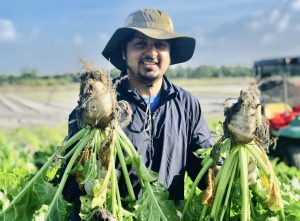FORT PIERCE, Fla.—It is the season to give, and Jaya Nepal wants to share his research findings with food producers in the world’s sandy soil regions.
“With less than 4% of the globe’s sandy soil regions utilized for crop production, we have found a way to amend sandy soils and produce high-value crops,” said Nepal. “Global challenges such as population increases, food shortages, and increased climate variability inspire our work.”

Newly minted Ph.D., Dr. Jaya Nepal
Nepal completed a Ph.D. in Soil, Water, and Ecosystem Sciences with UF/IFAS at the Indian River Research and Education Center (IRREC) in Fort Pierce, Florida, an area around which sandy soils hold minimal nutrients.
In traditional agriculture, fertilizers add bulk nutrients to the soils, but crops can only absorb a small fraction of the nutrients in sandy soils, so the unused compounds leach through the soils into water resources. Growers can minimize leaching by using nanoparticle nutrients such as nitrogen, potassium, and phosphorus. The scientists target the carbon nanoparticles to specific plant parts and soil-crop management systems. In this way, growers can improve crop production, enhance soil fertility, and safeguard groundwater, Nepal said.

Carbon nano materials
“Carbon nano materials have a large surface area and carry a negative surface charge. When applied to soil as an amendment, carbon nano materials retain positively charged nutrients from leaching loss, and thus increase their availability to plants or fertilizer use efficiency, as evidenced from Jaya’s research work,” said Zhenli He, a professor of soil and water science, IRREC associate director, and Nepal’s graduate advisor.
The possibility opens great potential to utilize world sandy soils because about 900 million hectares of the world’s soils are sandy. Such land is marginal, and with the addition of carbon nano materials, the fields could become crop production land, said Zhenli He.
Carbon nanoparticles, or carbon nano materials, appear as an ultrafine black powder and hold a high concentration of nutrients valuable to the beets, corn, and lettuce varieties Nepal planted, grew, and then harvested for data. Nepal designed several crop experiments and sowed seeds in fields and greenhouses to evaluate the particles. The evaluation process involved harvests, monitoring crop growth, measuring, and laboratory analyses for soil quality analyses. Soil leaching studies were conducted in a laboratory, with a platform of upright tubes filled with two soils common to the central coastal Florida region.
Results from the column soil leaching studies were significant. Nepal found that carbon nano materials reduced leaching of all three nutrients: nitrogen, potassium, and phosphorus. However, Nepal found the most significant leaching reductions in the columns he applied higher amounts of carbon nano materials to simulate intensive fertilization systems such as corn production.
In greenhouse experiments, Nepal found that lettuce took up more nutrients when small amounts of carbon nano materials were added to the soil compared to plants to which traditional fertilizers were applied.

Sugar beets and field corn cropping
In experimental fields, Nepal grew sugar beets and field corn.
“Field trials and experiments took place continually until crop harvest times to test the carbon nano materials,” said Nepal. “I rely on prime growing conditions for southern Florida to develop enhanced, resilient crops and innovative growing techniques that produce higher quality yields all year round.”
Corn and beets produced more leaves, and the crop yields were 18-20% higher with carbon nano materials compared to without amendments. Also, the soil was more fertile, and its natural biological activity was healthier at low to moderate application rates, Nepal found.
Nepal said that overall, moderate amounts of carbon nano materials applied to the test soils increase crop yields by up to 20%. He also found that the test soil amendments added nutritional value to his harvested crops, increasing quality of fresh produce.
The results of the studies were consistent in both greenhouse and field experiments. The carbon nano materials enrich soil health and nutrition in crops grown in Florida’s coarse, sandy soils. Nepal recommends more research with soils in other sandy soil growing regions and with different crops. Expanded research will optimize the application rates and method of carbon nano materials for varying soil and crop conditions, Nepal said.
“Our aim is to maximize food production on underutilized land due to sandy soils, that cannot retain nutrients efficiently,” said Nepal. “I want to contribute to global efforts to fight hunger, and the findings from our research are highly promising.
Nepal will begin a position as a postdoctoral research associate at Cornell University in mid-January.
 12
12
